Chapter 19.06
FRANCHISE UTILITIES AND STREET LIGHTING1
Sections:
19.06.010 Application of chapter.
19.06.030 Public works standards.
19.06.060 Undergrounding of existing overhead utilities.
19.06.070 Placement of underground cable television conduits.
19.06.080 Overhead electrical transmission facilities.
19.06.090 Liability for costs.
19.06.100 Installation – City engineer approval.
19.06.120 Existing city franchises not affected.
19.06.010 Application of chapter.
The provisions of this chapter shall apply to all new and existing franchise utility systems including, but not limited to, electrical (including street lighting), gas, communications, and all other franchise utilities, except for major utility facilities as defined and regulated under NBMC Title 18. (Ord. 1588 § 1 (Exh. A (part)), 2016).
19.06.020 Purpose.
The purpose of this chapter is to establish minimum requirements for the underground installation and relocation of franchise utilities within the city. It is further the policy of the city to require the underground installation of all new franchise utilities, and the relocation of existing franchise utilities underground when affected by new development or redevelopment under the provisions of this chapter. The city finds that the health, safety, and general welfare of the residents of the community require that all new and relocated facilities specified in this chapter be installed underground. (Ord. 1588 § 1 (Exh. A (part)), 2016).
19.06.030 Public works standards.
This chapter provides minimum requirements for franchise utilities and street lighting. Detailed standards and technical specifications pertaining to construction and installation of these facilities are found in the city’s public works standards. (Ord. 1588 § 1 (Exh. A (part)), 2016).
19.06.040 Definitions.
Unless otherwise specified below, definitions shall be as provided under NBMC Title 18, Zoning.
A. Electrical distribution facilities include those electrical utility lines and equipment operating between 120 and 35,000 volts that provide direct service to customers.
B. Electrical transmission facilities include those electrical utility lines and equipment operating above 35,000 volts transmitting power from generating stations to substations.
C. New development or redevelopment for purposes of this section includes any one of the following conditions:
1. A land use or building permit for a new building or land use where frontage improvements are required; or
2. A building permit for a project where the cost of construction equals or exceeds 50 percent of the assessed value of the existing structure on site, excluding interior remodel of existing single-family residential structures and auxiliary buildings. (Ord. 1588 § 1 (Exh. A (part)), 2016).
19.06.050 New utilities.
All new franchise utility facilities installed for new development or redevelopment shall be placed underground, with the following exceptions:
A. Electrical transmission facilities.
B. Wireless communication facilities (see applicable code section).
C. Accessory franchise utility facilities less than 36 inches in height such as meters, junction boxes, transformers, and the like, when placed at least five feet from the edge of sidewalk, pavement edge or back of ditch and screened with landscaping compliant with franchise utility standards.
D. Accessory franchise utility facilities greater than 36 inches in height, when located within a building or placed in a nonprominent location on the side or rear of the building or at least 10 feet from the right-of-way or other public areas, and located behind a minimum of five feet of Type 1 landscaping pursuant to Chapter 18.18 NBMC and franchise utility standards. (Ord. 1588 § 1 (Exh. A (part)), 2016).
19.06.060 Undergrounding of existing overhead utilities.
A. Undergrounding with New Development or Redevelopment. Existing aboveground wiring and related equipment for electrical distribution facilities, communication facilities, and other purposes, except for wireless communication facilities, transformers, junction boxes and the like, shall be relocated underground along the property frontage when the development or redevelopment requires a subdivision or short subdivision pursuant to Chapter 17.12 NBMC, a binding site plan pursuant to Chapter 17.20 NBMC, or site plan approval pursuant to Chapter 18.14 NBMC, except when the right-of-way frontage of the new development or redevelopment is less than 150 feet in width along the frontage containing the aboveground wiring; and
1. The new development or redevelopment does not require relocation of the existing aboveground wiring to accommodate the required site or street frontage improvements; or
2. The city engineer determines that the undergrounding of the portion of the existing aboveground wiring along the development or redevelopment’s street frontage would require undergrounding portions of the existing aboveground wiring beyond the development’s street frontage, unless such additional undergrounding is no more than 50 feet beyond the property line on either end of the street frontage to connect to logical points of the existing utility system;
B. Where undergrounding is not required for a new development or redevelopment under one of the exemptions listed in subsection A of this section, and street frontage improvements are required, the applicant shall provide conduit within the street frontage improvements for the future undergrounding of the aboveground wiring. The conduit shall be of sufficient size and dimension to accommodate the projected maximum line size required for all franchise utility facilities to be undergrounded;
C. Undergrounding with Publicly Funded Street Improvements. As major publicly funded street improvements are undertaken within the city and where such programs require electrical, telephone or TV cable distribution facilities relocation, such facilities shall be relocated underground, unless exempted by action of the city council;
D. Relocation Time Limit. As overhead franchise utility facilities are relocated underground, the applicant shall have all overhead connections undergrounded and shall connect to the new underground facilities within 90 days of the date of undergrounding completion. A franchise utility provider’s compliance with this 90-day time limit is excused if unforeseen events or circumstances beyond the reasonable control of the franchisee, including acts of God, render timely performance impossible, infeasible, or impracticable, or if, despite the franchisee’s best efforts, performance cannot be timely without posing risks to public safety and service requirements. (Ord. 1588 § 1 (Exh. A (part)), 2016).
19.06.070 Placement of underground cable television conduits.
When an applicant and/or landowner extends basic utilities to serve a building site, cable television conduits shall be laid underground at the same time as those other basic utilities. This will include only the conduits needed for street crossings and for mainline distributions of cable television to each building site throughout any proposed development. All conduit ends shall be brought to each building site property line, elbowed to the final ground elevation and capped. If the proposed development site is for multiple-family occupancy, then the conduit shall be so laid and be of sufficient dimension to ensure that cable television service may be connected to each of the proposed living units. (Ord. 1588 § 1 (Exh. A (part)), 2016).
19.06.080 Overhead electrical transmission facilities.
Franchise utility providers proposing new or replaced overhead electrical transmission facilities shall utilize appropriate measures to mitigate the visual appearance of such facilities on surrounding landscapes and views. Measures shall be determined based on the context of the facility and in consultation with the city, and should address pole height, pole spacing, materials and color as necessary to blend with surroundings, and co-location with other facilities to the extent possible. (Ord. 1588 § 1 (Exh. A (part)), 2016).
19.06.090 Liability for costs.
The applicant and/or landowner shall pay the costs required for the franchise utility provider to install or underground the utilities, including removal of the existing overhead facilities if required, and install conduit to each individual property line, including conduit, trenching and easements; provided, the costs of extending the utilities and conduit across the frontage of the build-site or development to the next property line shall be eligible for latecomer’s agreement. (Ord. 1588 § 1 (Exh. A (part)), 2016).
19.06.100 Installation – City engineer approval.
Design and installation of new and relocated utilities shall be done by the franchise utility company. All work shall be installed in accordance with industry standards for the associated utility and shall be subject to the approval of the city engineer. The applicant and/or landowner shall provide necessary occupancy rights and easements for the pad-mounted transformers and other accessory facilities necessary for the furnishing of such utilities. (Ord. 1588 § 1 (Exh. A (part)), 2016).
19.06.110 Street lighting.
A. When Required. When a development or redevelopment requires a subdivision or short subdivision pursuant to Chapter 17.12 NBMC, a binding site plan pursuant to Chapter 17.20 NBMC, site plan approval pursuant to Chapter 18.14 NBMC, or frontage improvement pursuant to the adopted public works standards, the applicant shall provide street lighting within existing and new public rights-of-way in accordance with these standards, and those in the public works standards if existing street lighting is not already provided.
B. Ownership and Other Requirements.
1. Public Street Lights. Street lights within public rights-of-way shall be owned by the city or franchise utility provider, or as otherwise determined through utility franchise agreements.
2. Private Street Lights. Street lights on or along private alleys, roads or streets, on private property, or not otherwise within a public right-of-way, shall be privately owned and operated.
C. Billing to franchise utility providers for energy use for all street lights internal to new residential subdivisions shall be paid for by the homeowners association of the subdivision. All street lights along all other public streets shall be paid for by the city.
D. Energy Conservation Lighting Fixtures. All new street lighting shall utilize LED fixtures, or other equivalent best available technology that provides sufficient lumen output while reducing energy consumption, except where necessary to match existing lighting fixtures in an infill situation. To provide warmer lighting tones that reduce glare and night-sky pollution, fixtures shall provide a correlated light color temperature not to exceed 3,000 kelvin.
E. Minimum Lighting Requirements. Street lighting shall be provided at all intersections within and abutting the development, at the end of dead-end streets containing more than three homes, and in any additional areas such as curves in roads and trails for pedestrian lighting or crosswalks consistent with NBMC 17.25.065(B)(4) where determined necessary for safety by the public works director or CED director. Street lighting shall utilize full cut-off fixtures to minimize glare. The street lighting shall be designed to provide a minimum light intensity at intersections as specified in the table below, or greater when determined necessary for safety by the public works director. Detailed construction and facility street lighting specifications, including specified pole and fixture design in certain areas, are provided in the public works standards.
|
Street Classification |
Average Lighting – Foot-Candles in Areas Where Lighting Is Required |
|---|---|
|
Arterial |
0.6 |
|
Collector |
0.4 |
|
Local Access/Half-Street |
0.4 |
F. To provide consistency with existing lighting, the city requires the following fixture types on public streets. If one or more of the listed styles or manufacturers is discontinued, prior written approval from the city is required before a different type may be installed.
1. Collector Streets: Ameron Centercon-Series Octagonal concrete pole or similar in black and cobra head. 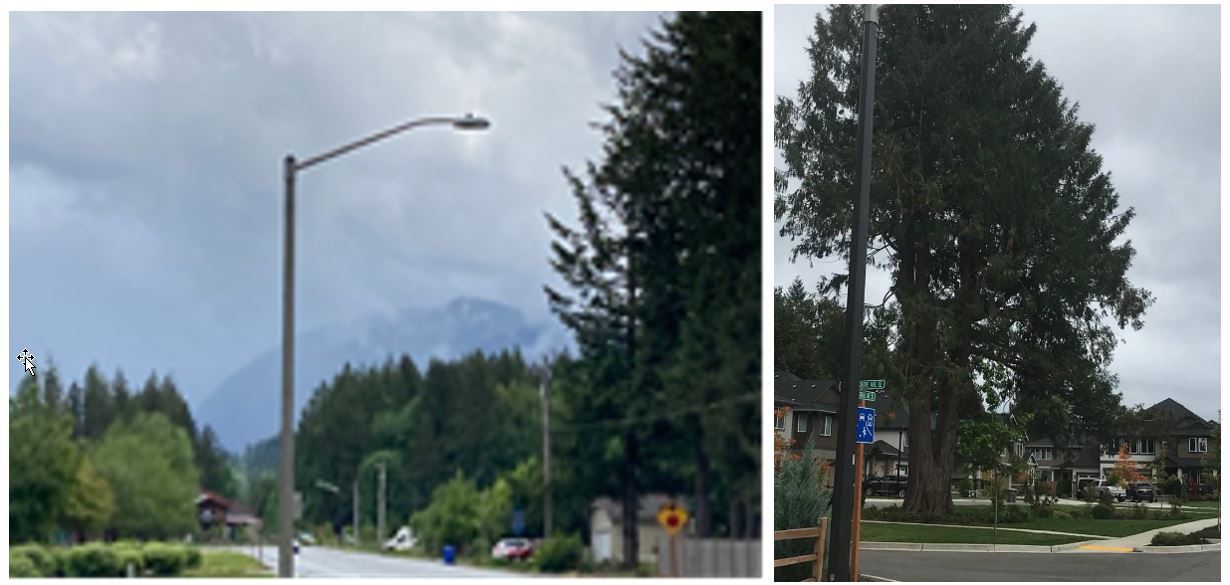
2. Arterial Streets: Ameron Round Class-B Medium Duty concrete pole or similar in green aggregate, S-shaped arm with decorative scroll bracket in black, and black cobra head fixture.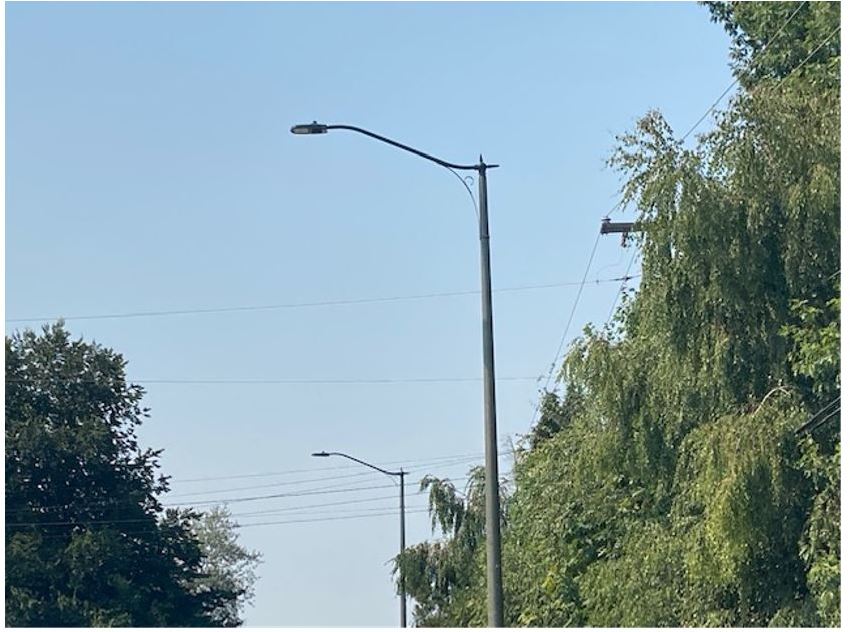
3. Pedestrian Lighting in the DC Zone: MetroScape MPTR, RA61. Poles shall include electrical box. Street trees more than five feet from poles shall also include electrical box and/or plug with locking outlet as determined by the city. Accessory arms for banners or flowerpots and irrigation may be required on a project-by-project basis. This style may be used at other locations as approved by the director.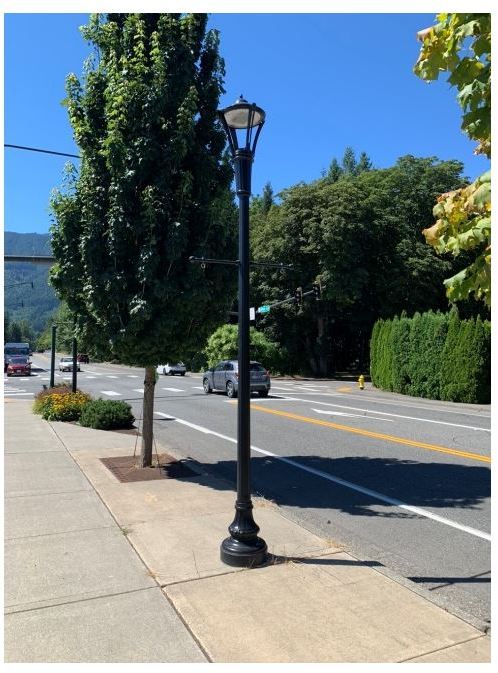
4. Street Intersection Lighting. When new development or undergrounding occurs, lighting shall be added at a minimum to the intersections in the DC zone identified below. Poles shall include electrical box and accessories as required. The poles and arms shall be one of the following, or equivalent:
a. Architectural Area Lighting: DB3 round decorative pole (5R25-250), and SLA 1 single arm.
b. H.E. Williams: Aluminum decorative pole VM-AV50-A-250-40-188-T, and AVPT24 short single short arm.
c. Philips-Lumec: Aluminum decorative pole (SAM8V-23), and MR-1A Medium Reach bracket.
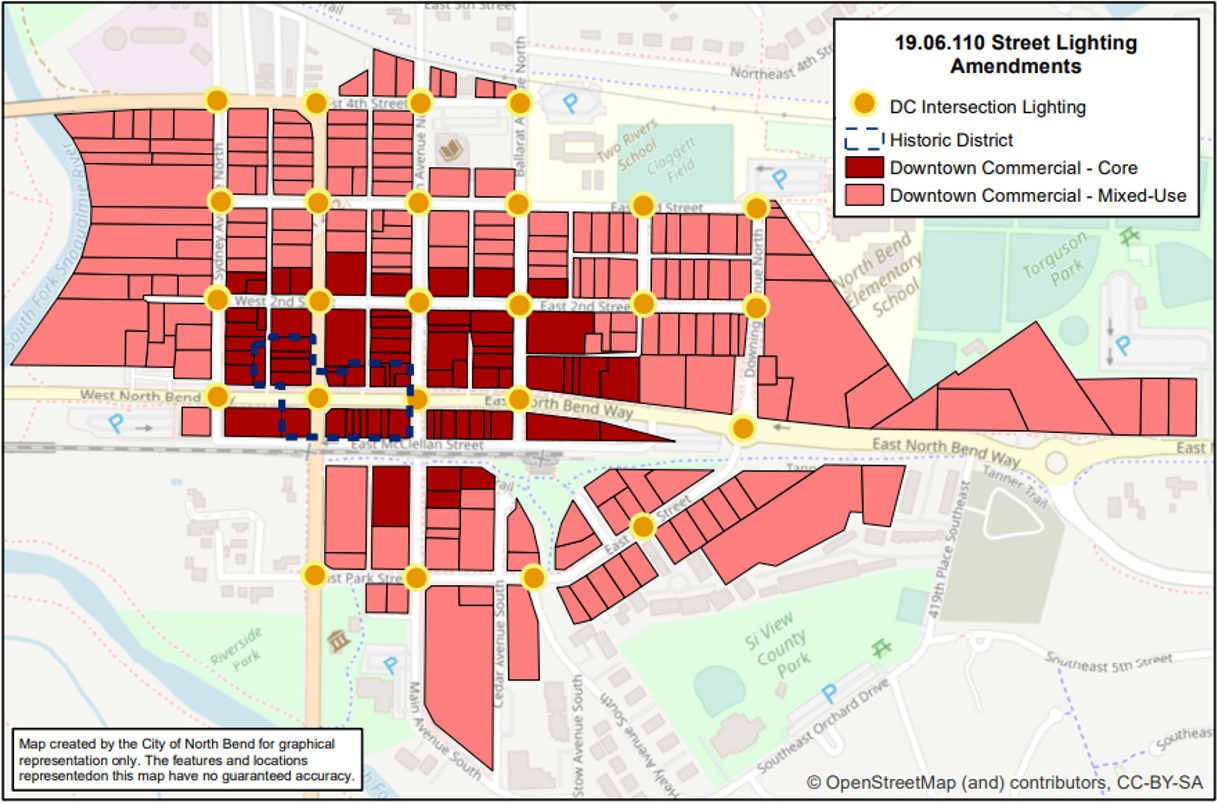
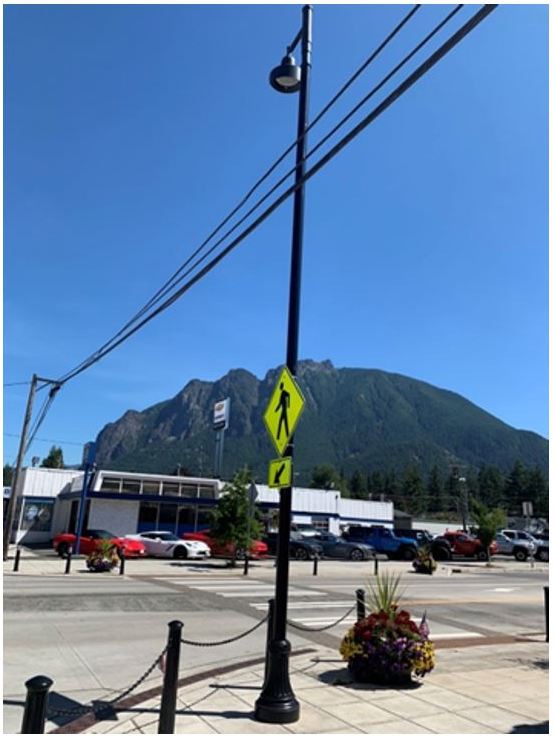
5. Plats. If plats contain arterial or collector lighting, neighborhood lighting shall be consistent with the lights in this chapter or a complementary style with approval in writing by the CED director. (Ord. 1768 § 1, 2022; Ord. 1588 § 1 (Exh. A (part)), 2016).
19.06.120 Existing city franchises not affected.
This chapter shall not affect or waive any right or obligation of a city franchise for use of the city right-of-way, and shall be applied consistent with any applicable tariffs and regulations of the Washington Utilities and Transportation Commission. If a provision of this chapter conflicts with a provision of a franchise agreement or ordinance, the provision of the franchise agreement or ordinance shall control. (Ord. 1588 § 1 (Exh. A (part)), 2016).
Prior legislation: Ords. 720 and 972.


